Download 1up Font Family Style
Download 1up Font Family

1up is a retro font that is influenced by classic video games and modern pixel fonts. Looks great in display sizes and also works well when used smaller.

1up is a retro font that is influenced by classic video games and modern pixel fonts. Looks great in display sizes and also works well when used smaller.
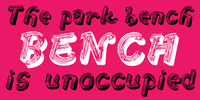
1st Ave is the most experimental of my typefaces. I took a picture of a metal and neon sign in the East Village of New York City. These signs are slowly being replaced by LED and LCD displays, but if you look hard, you can still find quite a few in the city.
The signs give a mid 20th century feel to the city. To design 1st Ave, I took a picture of the sign, scanned it and increased the contrast in Photoshop so that the photographic forms became line art.
There weren't enough letterforms in the sign to create the whole alphabet, so I cut up the strokes and collaged them back together to finish the entire alphabet.
Important Note: 1st Ave is an experimental typeface and is not compatible with certain software such as Microsoft Word.
family of 4 fonts from Matthias Luh
19th Century Retro is a re-design of an official German font style (called Fraktur) which was used in official documents in the 19th and early 20th century.
family of 4 fonts from Matthias Luh
19th Century Retro is a re-design of an official German font style (called Fraktur) which was used in official documents in the 19th and early 20th century.
This font was inspired by the rare manuscript Roman Quadrata used by an unknown scribe to inscribe a copy of the Roman poet Virgils GEORGICS, somehwere around 161 to 180 AD. Only a few sheets have survived, now preserved by different libraries around the world. More…
In creating this font, we have adapted it for contemporary users, making differences between U and V; I and J (which made no difference at all to ancient Latin scribes) and naturally adding the glyphs for Thorn, Oslash, Lslash, W, Y, as well as the usual accented characters and punctuation, none of which existed at the time. Only capitals are present in the original; but we have provided alternates: so alternating each character A-Z/a-z will give a pleasant appearance of manual script. We have added the Roman numerals I V X L C D M in the OTF/TTF versions usable as Old Style Numerals alternates.
This font was inspired by the rare manuscript Roman Quadrata used by an unknown scribe to inscribe a copy of the Roman poet Virgils GEORGICS, somehwere around 161 to 180 AD. Only a few sheets have survived, now preserved by different libraries around the world. More…
In creating this font, we have adapted it for contemporary users, making differences between U and V; I and J (which made no difference at all to ancient Latin scribes) and naturally adding the glyphs for Thorn, Oslash, Lslash, W, Y, as well as the usual accented characters and punctuation, none of which existed at the time. Only capitals are present in the original; but we have provided alternates: so alternating each character A-Z/a-z will give a pleasant appearance of manual script. We have added the Roman numerals I V X L C D M in the OTF/TTF versions usable as Old Style Numerals alternates.
This family was inspired by the edition De Civitate Dei (by Sanctus Augustinus) printed in 1467 in Sobiano (Italy, Roma) by Konrad Sweynheym and Arnold Pannartz who was the Punchcutter. It is one of the first few “Roman style” fonts, just before the birth of Jenson’s pattern (look at 1470 Jenson Latin).
The present font contains all of the specific latin abbreviations and ligatures used in the original (about 54). Added are the accented characters and a few others not in use in this early period of printing. More…
Decorated letters such as 1512 Initials, 1550 Arabesques, 1565 Venetian, or 1584 Rinceau can be used with this family without anachronism. If Italic style is required,(no longer existing in early time of printing) we recommend using 1557 Italique.
family of 1 font from GLC
Font designed from that used in Bamberg by Albrecht Pfister, in early years of printing, exactly for a book titled "Ackermann Von Bhmen" writen in old German by Johannes Von Tepl, and decorated by a lot of splendid colored carved woods. This font include “long s”, naturelly, as typically medieval, but any abbreviated characters, and, curiously no german "", no more than “W”. (The only one I did found where a hand drawn one.)
family of 1 font from GLC
Is it necessary to tell the Gutenberg story?
family of 1 font from GLC
Is it necessary to tell the Gutenberg story?
family of 1 font from GLC
This script font was inspired by the type most commonly used during the period 1300s to 1500s.
family of 1 font from GLC
This rough font was inspired from a Russian Cyrillic hand of 1350’s “Russkaja Pravda” (a Russian text of common Laws). As a Pro font, It is containing Western and Northern European, Icelandic, Baltic, Eastern, Central European and Turkish specific characters, but, naturally Old Russian glyphs, including a lot of them not in use from 1700’s, excepted for religious texts, at all more than 136 Russian Glyphs. Capitals and lower cases have the same form and almost same size, like in the original text, who was using only one size and style.
Im really glad to announce that today we have the 1000 fonts that are featured on Kreativ Font.
To anyone that contributed to this unbelievable milestone THANK YOU!
Stay tuned, many new features are in the works that will make Kreativ Font even more attractive and usable.Also, please do not hesitate to let us know you wishes
family of 5 fonts from DMTR.ORG
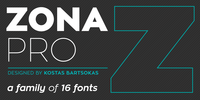
Zona Pro is a geometric sans-serif type family of 8 styles plus matching italics, designed by Kostas Bartsokas in 2013/14. It draws inspiration from 1920s geometric style faces, having clean and highly readable shapes, and mixes it up in the heavier weights with a slight variance in the stem widths, lending it a grotesque-ish unique and distinctive look.
Zona Pro is multifunctional and versatile.
With its modern yet elegant form it performs amazingly in display sizes and headlines. At the same time its really tall x-height makes Zona Pro equally suited for editorials and shorter lines of text in smaller sizes (magazines, newspapers).
More…
Zona Pro supports Greek, Western, Central and Eastern European languages, ligatures and special characters.
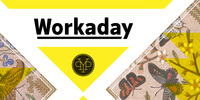
Workaday from Yes Please is a bold and clean contemporary take on the classic American Sans Serif. Inspired by the wildly varied history of early to mid 20th century American signage, aircraft markings and industrial shipping vernaculars, Workaday exudes a timeless, classic flavor packed with a personality perfect for graphic headlines, packaging, copy setting and much more! Workaday features conventional ligatures, a standard set of accents and symbols, and a set of open type alternate characters to provide a versatile end-user experience.
Workaday has seen action for Nike Sportswear, MSN, IFC, FX and more. Workaday is designed by Lee Schulz.

Wonderhand is a new extensive family of scripts designed in six widths and 3 weights. It also introduces a third design axis, the slant, presenting an upright cut, a 20 degrees cut and a 40 degrees cut for each.
Like written by different hands, eat cut has a difference appearance and character.
Wonderhand contains two sets of alternate characters and automatic features that imitate the natural flow of handwriting.
It is loaded with icons and decorative elements that allow multiple possibilities in layout design.
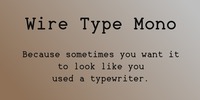
A monospaced typeface meant to look and feel like an old typewriter.
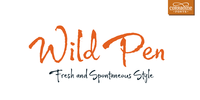
Wild Pen is a handwriten font written with an experimental pen made from recycled plastic bottle.
Its spontaneous strokes are very free and allow presence of drops and blots of ink. The complete family consists of five different fonts which have the same feeling and allow mixing them to obtain a lifelike handwriting text.
More…
Open Type users may choice Wild Pen OT, wich includes not just the five basic sets but also contains many additional alternative characters and some discretionary ligatures.
Wild Pen OT is judiciously programmed to mix randomly the five basic sets and improve the texts with the additional alternative characters which have in some cases up to ten additional letters for each character.
Wild Pen contains almost 1200 glyps to cover many Latin languages (Western and Central European).
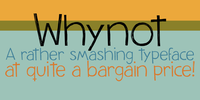
Whynot is a beautiful, hand drawn font - quite similar to Whatnot font, but with lower and upper case letters. Whynot can be used for almost all designs, in particular for posters, books and ads.
Whynot comes with a full range of diacritics and the glyphs are freely interchangeable with those of Whatnot font.
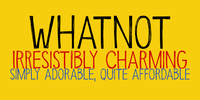
Whatnot is a beautiful, hand drawn all caps font. It was made with a fine-liner on smooth paper. Whatnot can be used for almost all designs, in particular for posters, books and ads. Whatnot comes with a full range of alternate lower case letters and upper and lower case are freely interchangeable.
Vulcano is the mesmerising creation of Salvador Tori Alimbau, the one-type-man who gave us this maze. Jos Manuel Urs took months to devise a negative-positive system for these characters. Hypnotic, charming sophisticated.